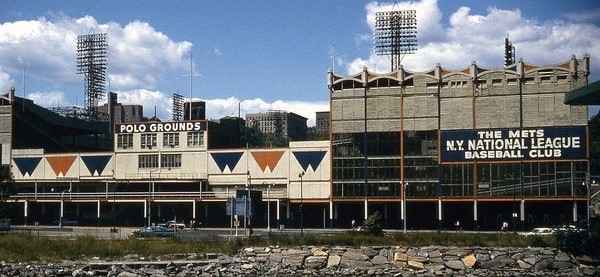Polo Ground III or Brotherhood Park was the last three “bathtub-style” ballparks built in Manhattan, New York City. It was the very baseball stadium that made the name Polo Grounds engraved in the annals of baseball history. Located near Coogan’s Bluff near the Harlem River, Polo Grounds were home to New York Giants baseball team, New York Yankees, and the New York Mets. The Giants, who were the first NL franchise to play at the ballpark moved to San Francisco in1957 and now play at Oracle Park. Polo Grounds was one of the most popular sports facilities when it used to host baseball games in New York City. It was also the venue for boxing matches, World Series, and even Army-Navy games.

The History
Original Polo Grounds ceased to exist in 1890. The replacement Polo Ground II near the Metropolitan Field fell into disarray after the Giants moved to the adjacent new stadium, which became Polo Ground III. After the grandstand of Polo Ground II was demolished in 1895, the new ground became the address of New York City’s famed Polo Grounds.
Built in 1890, Polo Ground III ballpark served as one of the most loved and enjoyed sports venues in New York City. At least one game was played every day in the Polo Grounds, which was located off the Harlem River in Manhattan at the footsteps of a beautiful hill inside an open meadow. This hill is termed the Coogan’s Bluff and the spectators often stood on it to view the game without buying a ticket.

Originally, it had an open outfield that was bounded by an outer fence. By 1900, it had bleachers extending up to the foul lines in some parts of the baseball stadium. Ever since its opening, Polo Grounds was called Brotherhood Park after the Brotherhood of Professional Baseball Players, which started the Players’ League in 1890. The New York Giants played in the Players’ League but moved to the National League the very same year. With this, Brotherhood Park became Polo Grounds III. For the first few years when both Polo Grounds II and Polo Grounds III were operational, fans sitting in the upper deck of the latter can watch games at the former ballpark.
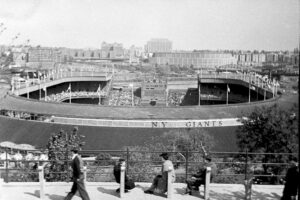
Fire and Reconstruction
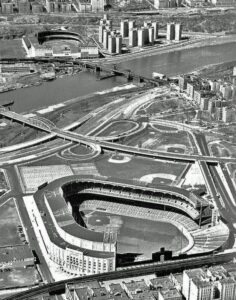
A fire burnt down Polo Grounds on April 4, 1911. However, many parts were saved due to the gap between different sections. While the Giants played at Hilltop Park, their owner John Brush reconstructed Polo Grounds in three months. Opened on June 28, 1911, fans rechristened it as Polo Grounds IV. However, the franchise named it Brush Stadium, which faded into oblivion in a few years as fans favored the name Polo Grounds. The new structure was of concrete and steel – the fourth such NL ballpark and ninth MLB stadium – had more seats than the previous one.
Between 1913 and 1922, it was home to the New York Yankees. In 1923, they built Yankee Stadium and left Polo Grounds. 1923 saw more renovations with the extension of the double deck and the addition of center-field bleachers and clubhouse. But the new arrangement made it for suitable for football than baseball.
The End of An Era
The emergence of “jewel box” ballparks led to Polo Grounds losing its fan-favorite status. Yankee Stadium soon eclipsed it and emerged as NYC’s greatest sports symbol. The surrounding areas deteriorated for want of upkeep. The baseball stadium also witnessed negligence and lack of maintenance in the late 1940s and this continued. Even though the Giants had good seasons and won the World Series, attendance began to fall and only a million fans attended games during the 1954 season. In 1956, this was reduced to almost half. The football Giants moved out too. Polo Grounds suffered financial distress and laid off the maintenance staff to save money.
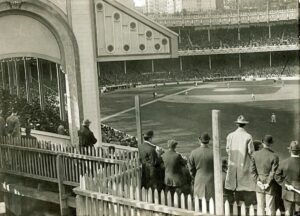
Fans also faced inconveniences due to the lack of amenities, parking issues, and entry and exit problems. The obsolete and dilapidated condition added to their woos. This led the Giants to announce their move to San Francisco in 1957. After a gap of four years, football returns to Polo Grounds in 1960 when the Titans of New York made it their temporary home. However, the Titans left for Shea Stadium in 1964. The New York Mets also played in Polo Grounds in 1962 and 1963.

The end of Polo Grounds started in 1961 when the city administration wanted to claim the area, demolish the dilapidated ballpark, and construct housing units there. It had its last baseball game on September 18, 1963. Only 1,752 fans attended it. The baseball stadium was officially closed on December 13, 1963, and the demolition began on April 10, 1964, by workers wearing Giants’ jerseys. Today, the Polo Grounds Towers stand at the very place where New York City’s baseball cradle once stood.
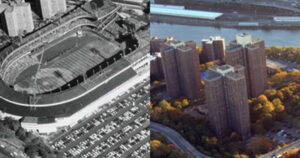
Features
Polo Grounds was initially an open ground and bleachers led to the evolvement of the stadium. There was a time when bleachers encroached on the foul lines in the 1900s. There were also some cigar boxes on the sides of the “batter’s eye.” In 1910, the bleachers enclosed the outfield and the carriages ropes were no longer there. There was also an expansive outfield that was cut down with a rope fence. Carriages used to be parked behind that. In between the bleacher sections, there was some space that saved the stands from fire in 1911.
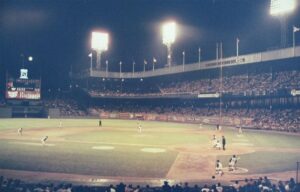
For getting the tickets, fans had to walk down the long stairway called John T. Brush Stairway right from the top of the bluff so that they could reach the ticket counters. The staircase was built in 1913 and named after the long-term owner of the Giants who passed away earlier in 1912. The ballpark was made mostly out of wood. The ballpark had two decks. The earlier version of the Polo Grounds could accommodate about 16,000 fans. It also had some spaces behind the center field where the fans could watch the match with their horses. It was very common for the people to watch the match by hovering all around the deep areas of the outfield. This was because the “dead ball” that was used to play the game did not travel too far away. A rope was set to demarcate the boundary and prevent them from interfering in the game.

When it was rebuilt in 1911, Polo Grounds retained the surviving wooden stands. The new additions were made of steel. In 1923, there was the extension of the double deck and new bleachers replaced the old ones. The roof extended 21 feet into the left field and flying balls often hit it. Light poles were moved to Phoenix Municipal Stadium following the San Francisco Giants’ spring training there in 1964.
Purely Baseball Things To Know
- Polo Grounds hosted the San Francisco Giants, the New York Mets, and the New York Yankees, three key MLB teams with a large fan following.
- Polo Grounds hosted World Series in 1911, 1923, 1924, 1933, 1936, 1937, and 1951 and All-Star Games in 1934 and 1942.
- The San Francisco Giants won 15 NL pennants and 5 world series while playing at Polo Grounds.
- The Yankees won their 1922 AL Pennant at the ballpark.
- In the 1954 World Series, Willie Mays caught an almost home run hit by Vic Wertz of the Cleveland Indians. The catch with the backdrop of a metal screen became an iconic symbol for the Giants’ fans.
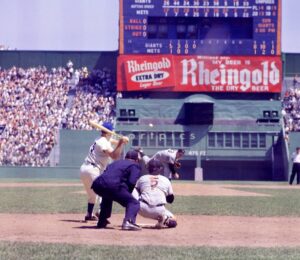
- Polo Grounds hosted the first night game on May 24, 1940.
- On October 3, 1951, the Giants rout the Dodgers 5-4 to win the NL pennant. This game witnessed the famed “Shot Heard ‘Round the World home run” by Bobby Thomson of the home team.
- The only MLB death from injury during a game occurred at the baseball stadium on August 16, 1920. Ray Chapman of the Cleveland Indians died after a pitch by Carl Mays of the New York Yankees hit him.
- The Giants won the 1954 World Series but finished last in the 1956 MLB season.
- Polo Grounds hosted the last MLB game on September 18, 1963. The Philadelphia Phillies defeated the Mets 5-1. Only 1,750 fans attended the game signaling the end of the ballpark.
- All Latin American stars playing in the National Game came together on October 12, 1963, to play the last baseball game at Polo Grounds.
- Joe DiMaggio of the New York Yankees ran to catch a hit by the Giants’ Hank Leiber on October 2, 1936. The ball traveled 430–440 feet before he caught it.
- Polo Grounds was the place where Babe Ruth had many of his home runs going past 500 feet. In 1921, his hit traveled more than 550 feet.


